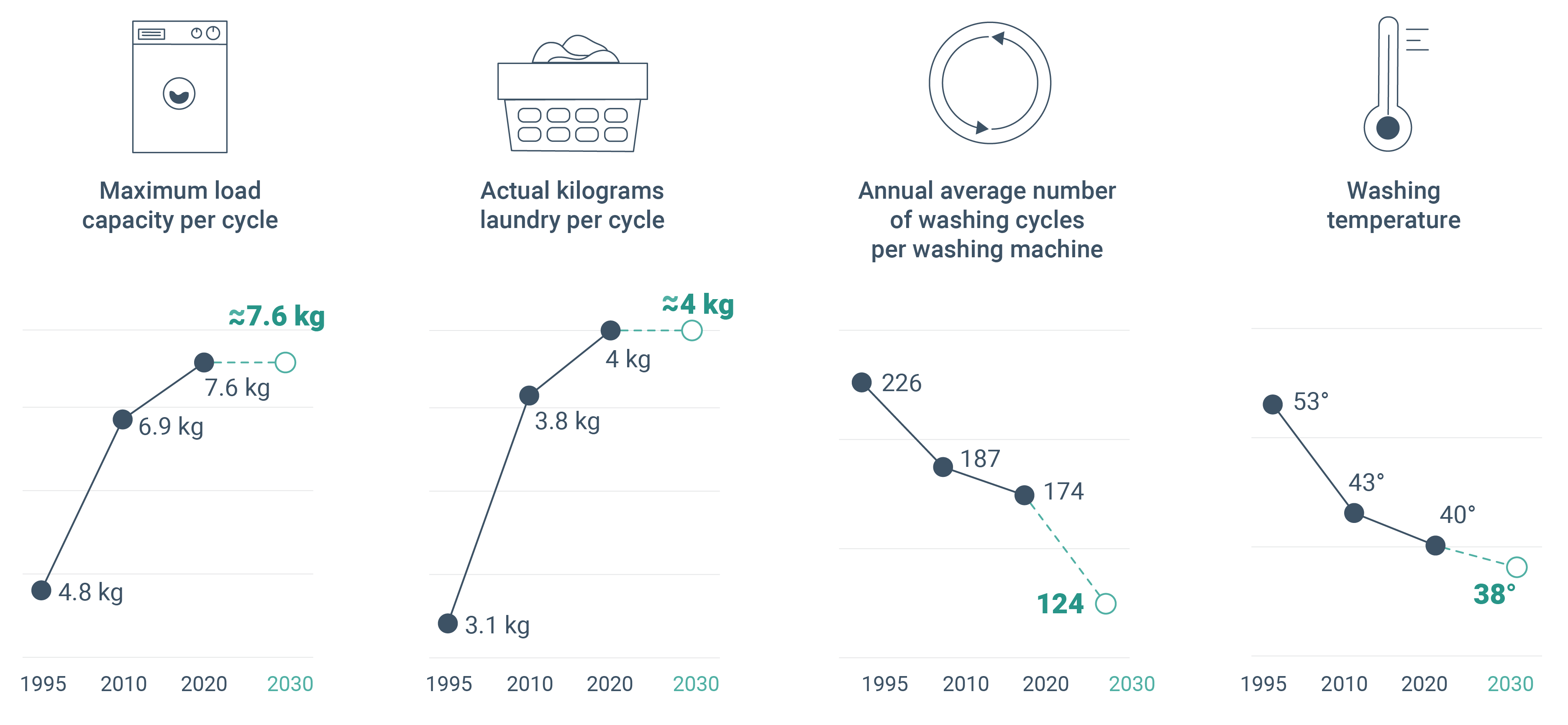All official European Union website addresses are in the europa.eu domain.
See all EU institutions and bodiesWashing machine capacity has increased, but utilization of this capacity has declined. We use individual washing machines less, but wash on lower temperatures.
The total annual volume of laundry in the EU27 has risen from 95 billion kg in 1995 (or 131 kg/person) to 121 billion kg (270 kg/person) in 2020, and it projected to reach 124 billion kg by 2030. (Source: 2023 EIA report) Considering the use intensity of washing capacity in Europe, we see the following trends:
· Washing machines have significantly increased in size over recent years. The maximum load capacity of these machines has grown by almost 60%, from 4.8 kg/cycle in 2015 to 7.6 kg/cycle in 2020. However, the actual average laundry amount per cycle remains lower than the capacity, rising more slowly (30%) from 3.1 kg/cycle in 1995 to 4 kg/cycle in 2020. Consequently, the load capacity has decreased from 65% in 1995, to 53% in 2020 of the maximum capacity. Beyond 2020, capacities are expected to stabilize. (Source: EIA report) As a result, we are utilising a smaller proportion of the available capacity in our washing machines.
· Looking at the overall stock of washing machines in Europe, we observe an increase. Large equipment put on the market in Europe in kg/capita has grown annually with 3% on average. In 2023, the average size of households in EU was 2.3 people (Eurostat, 2024c). This number has, however, decreased over time: in 1995, the average household consisted of 2.5 people (Eurostat, 2003). In parallel, the proportion of people living alone is increasing. The trend towards smaller household sizes in general leads to the purchase of more washing machines, and probably lower usage intensity. Numbers provided by the EIA report confirm this: the average number of washing cycles per machine per year dropped from 226 in 2015 to 174 in 2020, and it is projected to decline further to 124 cycles by 2030.
Kruschwitz et al. (2014) has analysed the washing behaviour of 236 private households across Germany. The study found that the average number of washing cycles per year in Europe varies significantly based on household size, with single-person households averaging 2.2 cycles per week and household with at least five people averaging 6.8 cycles per week. The study also confirmed that the average number of washing cycles per year is decreasing due to smaller household sizes and higher loads per wash cycle, although the maximum load capacity is often not used fully.
To conclude, the European stock of washing machines is growing and less intensely used. Washing machines are designed to handle a certain number of cycles over their lifespan. Using them less intensively means that their full potential is not being utilized, leading to inefficiencies in resource use. Knowing that modern washing machines have higher load capacities, use more advanced materials and technology than older ones, this leads to additional environmental impacts. On the positive side, laundry is now washed at progressively lower temperatures: 53°C in 1995, 40°C in 2020, and an anticipated 38°C by 2030. This trend positively impacts electricity consumption and our carbon footprint.
Continue browsing in the Circularity Metric Lab by visiting one of these thematic modules:
References and footnotes
- A household is defined as “a person living alone or a group of people who live together in the same private dwelling and share expenditures, including the joint provision of the essentials of living". Additionally, in higher performing economies, some households may own more than one residence, which could, in turn, further increase the demand for electrical and electronic equipment.↵





